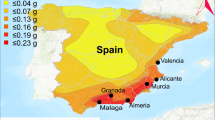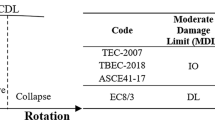Abstract
Seismic design using maps based on “risk-targeting” would lead to an annual probability of attaining or exceeding a certain damage state that is uniform over an entire territory. These maps are based on convolving seismic hazard curves from a standard probabilistic analysis with the derivative of fragility curves expressing the chance for a code-designed structure to attain or exceed a certain damage state given a level of input motion, e.g. peak ground acceleration (PGA). There are few published fragility curves for structures respecting the Eurocodes (ECs, principally EC8 for seismic design) that can be used for the development of risk-targeted design maps for Europe. In this article a set of fragility curves for a regular three-storey reinforced-concrete building designed using EC2 and EC8 for medium ductility and increasing levels of design acceleration \((\hbox {a}_\mathrm{g})\) is developed. These curves show that structures designed using EC8 against PGAs up to about 1 m/s\(^{2}\) have similar fragilities to those that respect only EC2 (although this conclusion may not hold for irregular buildings, other geometries or materials). From these curves, the probability of yielding for a structure subjected to a PGA equal to \(\hbox {a}_\mathrm{g}\) varies between 0.14 (\(\hbox {a}_\mathrm{g}=0.7\) m/s\(^{2})\) and 0.85 (\(\hbox {a}_\mathrm{g}=3\) m/s\(^{2})\) whereas the probability of collapse for a structure subjected to a PGA equal to \(\hbox {a}_\mathrm{g}\) varies between 1.7 \(\times 10^{-7}\) (\(\hbox {a}_\mathrm{g}=0.7\) m/s\(^{2})\) and 1.0 \(\times 10^{-5}\) (\(\hbox {a}_\mathrm{g}=3\) m/s\(^{2})\).






Similar content being viewed by others
References
Ambraseys NN, Douglas J, Sigbjörnsson R, Berge-Thierry C, Suhadolc P, Costa G, Smit PM (2004) Dissemination of European Strong-Motion Data, vol 2 using Strong-Motion Datascape Navigator, CD-ROM collection, engineering and Physical Sciences Research Council, United Kingdom
Baker J (2007) Probabilistic structural response assessment using vector-valued intensity measures. Earthq Eng Struct Dyn 36:1861–1883
Bond AJ, Brooker O, Harris AJ, Harrison T, Moss RM, Narayanan RS, Webster R (2006) How to design concrete structures using Eurocode 2. The Concrete Centre, London. ISBN:1-904818-4-1
CEN (2004a) Eurocode 2, design of concrete structures, part 1-1: general rules and rules for buildings, BS EN 1992-1-1: 2004. European Committee of Standardization, Brussels
CEN (2004b) Eurocode 8, design of structures for earthquake resistance, part 1: general rules, seismic actions and rules for buildings, BS EN 1998-1: 2004. European Committee of Standardization, Brussels
Chiou B, Darragh R, Gregor N, Silva W (2008) NGA project strong-motion database. Earthq Spectr 24:23–44
Crowley H, Colombi M, Silva V, Ahmad N, Fardis M, Tsionis G, Papailia A, Taucer F, Hancilar U, Yakut A, Erberik M (2011) Fragility functions for common RC building types in Europe, Tech. Rep. D3.1, Systemic Seismic Vulnerability and Risk Analysis for Buildings, Lifeline Networks and Infrastructures Safety Gain (SYNER-G), Project of the EC Framework Programme 7
Douglas J, Ulrich T, Negulescu C (2013) Risk-targeted seismic design maps for mainland France. Nat Hazards 65:1999–2013. doi:10.1007/s11069-012-0460-6
Fardis M, Papailia A, Tsionis G (2012) Seismic fragility of RC framed and wall-frame buildings designed to the EN-Eurocodes. Bull Earthq Eng 10(6):1767–1793
Gehl P, Seyedi DM, Douglas J (2013) Vector-valued fragility functions for seismic risk evaluation. Bull Earthq Eng 11(2):365–384. doi:10.1007/s10518-012-9402-7
Gehl P, Douglas J and Seyedi D (2014) Influence of the number of dynamic analyses on the accuracy of structural response estimates. Earthq Spectr (in press). doi:10.1193/102912EQS320M
Ghobarah A (2004) On drift limits with different damage levels. In: Proceedings of international workshop on performance-based seismic design concepts and implementation, June 28th–July 1st, 2004, Bled, Slovenia
Kirçil MS, Polat Z (2006) Fragility analysis of mid-rise R/C frame buildings. Eng Struct 28(9):1335–1345
Kwon OS, Elnashai A (2006) The effect of material and ground motion uncertainty on the seismic vulnerability curves of RC structure. Eng Struct 28:289–303
Lemoine A, Douglas J, Cotton F (2012) Testing the applicability of correlations between topographic slope and VS30 for Europe. Bull Seismol Soc Am 102(6):2585–2599. doi:10.1785/0120110240
Luco N, Ellingwood BR, Hamburger RO, Hooper JD, Kimball JK and Kircher CA (2007) Risk-targeted versus current seismic design maps for the conterminous United States. In: SEAOC 2007 convention proceedings
Luco N (2009) Preparation of new seismic design maps for building codes. In: 2009 COSMOS technical session
McKenna F, Fenves GL, Scott MH, Jeremic B (2000) Open system for earthquake engineering simulation (OpenSees). Pacific Earthquake Engineering Research Center,University of California, Berkeley, CA
Milutinovic Z and Trendafiloski G (2003) WP4 Vulnerability of current buildings, chapter 4.2. AUTH WP4 WG Approach, Tech rep, Risk-UE: An advanced approach to earthquake risk scenarios with applications to different European towns, European Commission
Neuenhofer A, Filippou FC (1998) Geometrically nonlinear flexibility-based frame finite element. ASCE J Struct Eng 124(6):704–711 (Paper 16537)
Rossetto T, Elnashai A (2003) Derivation of vulnerability functions for European-type RC structures based on observational data. Eng Struct 25(10):1241–1263
Rossetto T, Elnashai A (2005) A new analytical procedure for the derivation of displacement-based vulnerability curves for populations of RC structures. Eng Struct 7(3):397–409
Sezen H, Elwood KJ, Whittaker AS, Mosalam KM, Wallace JW and Stanton JF (2000) Structural engineering reconnaissance of the August 17, 1999 earthquake: Kocaeli (Izmit), Turkey, chapter 2: evolution of seismic building design practice in Turkey. PEER report
Silva V, Crowley H and Colombi M (2013) Fragility Function Manager 2.0, FP7 SYNER-G (Systemic seismic vulnerability and risk analysis for buildings, lifeline networks and infrastructures safety gain)
Spacone E, Filippou FC, Taucer FF (1996) Fiber beam-column model for non-linear analysis of RC frames: Part I. formulation. Earthq Eng Struct Dyn 25:711–725
Acknowledgments
This article was supported by the internal BRGM research programme VULNERISK/MULTIRISK/MIR2 2012 and 2013. We thank Pierre Gehl for his help in conducting the analyses presented here and his comments on an earlier version of this article. Finally, we thank Helen Crowley and an anonymous reviewer for their constructive and detailed comments on a previous version of this article.
Author information
Authors and Affiliations
Corresponding author
Rights and permissions
About this article
Cite this article
Ulrich, T., Negulescu, C. & Douglas, J. Fragility curves for risk-targeted seismic design maps. Bull Earthquake Eng 12, 1479–1491 (2014). https://doi.org/10.1007/s10518-013-9572-y
Received:
Accepted:
Published:
Issue Date:
DOI: https://doi.org/10.1007/s10518-013-9572-y




